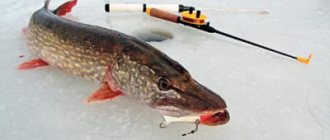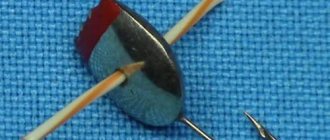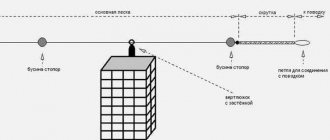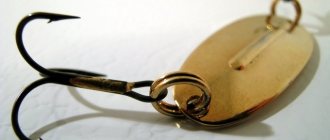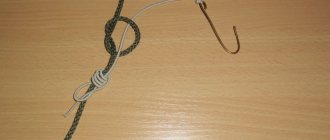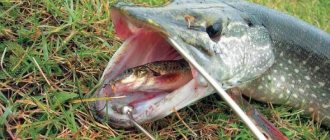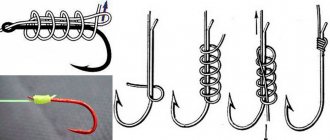So, damn...
This is a very successful lure from the mothless family. Catching bream from ice is often impossible without “devils”. A variety of shapes, colors, number of hooks - everything matters and ultimately the effectiveness. Most often, “devils” come in the form of a cigar, a drop, or an oblong cylinder.
These baits, being very active and quite large, can quickly scare off sluggish and sleepy fish during the winter “dead winter”. But in the spring, with fresh water and light entering under the ice, the fish becomes more and more reckless and tireless in searching for food, competing with other applicants for fatty larvae and underwater beetles. And here comes the time of the above-mentioned representatives of the inferno - “devils” from fishing stores... During this period, the fish begins to pay attention to the colors of the bait, although it has been said more than once that a jig is only a cargo that serves to deliver bait to the bottom. No, fish still somehow distinguish colors and react to them differently.
How to catch perch with the devil in winter
The correct technique for catching perch with a devil jig in winter is a fundamental condition for biting. No bait is used, the main thing is the correct game. In theory, this is only an average fishing technique. Playing with the devil is a constant experiment; both active and passive combinations work for perch. Each angler develops his own specific nuances over time.
- We rock the hole, attracting fish from afar, making strong vibrations. To do this, we lower the devil into the hole to the bottom, knock it a couple of times (to raise the turbidity) and toss and release 5-7 times to a height of 7-10 cm (like a spoon).
- Then - the main type of wiring. Stepwise dotted rises of the feature (like the movement of an amphipod crustacean). Every 10-15 centimeters is a pause. During the pause, a bite most often occurs. Amplitude, speed, height are experimental moments. This is selected on each fishing trip to find a working rhythm that attracts fish.
If it doesn’t bite, then we’ll improve our fishing technique by making provocations. Often the perch just stands and looks at the playing bait, not daring to attack it. To do this, we try various provocations:
- Changing the speed of the retrieve, reducing the size of the jig.
- An abrupt change in the type of game (for example, after repeated dotted lifts - a smooth pull up with acceleration, as if running away).
- Using the equipment of a steam locomotive (tandem). Below is a heavy devil, at the top is a light one (hook with beads, fly).
- Raising the turbidity by tapping the devil on the bottom.
During periods of activity, perch responds better to chaotic and fast movements. In the dead of winter, he is more likely to fall for the smooth and slow vibrations of the devil. In any case, during the fishing process you should try not to make parasitic movements in the horizontal plane. Devil is a jig for strictly vertical play.
Subscribe to the channel:
My YouTube channel RYBAFAN on fishing:
We're OK
Colors of bloodless “devils”
It has been noticed that on a gray day baits with a golden mirror and sparkles work well. In addition, it is not for nothing that reelless fishermen take with them various markers that can be used to change the color of the reelless jig during fishing. This is when suddenly a window of transparent sky opens in the middle of the gray sky, and then sunlight splashes onto the ice. And then the silver-plated bait will become falsely bright from the spring sun. It's time to darken it with a marker.
The so-called “white” fish are not as gambling as predators and often more confidently take gray-green or dark green jigs. Apparently this color, combined with the “devil” shape, reminds the fish of some kind of underwater larva, for example, the larva of a caddisfly or a dragonfly. Sometimes pure black lures are the most successful in catching bream. Catching roach can also be successful with black jigs.
Making a fishing devil from lead
I propose the first method of making fishing devils from lead with our own hands, as a result of which we will get reelless jigs of different sizes and weights.
During the work we will need a soldering iron. For fishermen who do not yet have a soldering iron, I suggest using the link at the bottom of the page to go to the training material, after reading which you can make a devil with your own hands without using a soldering iron.
The bodies of a batch of homemade devils can most quickly be made from some bulky piece of soft lead or a thick lead sheet.
If you have sheet lead with a thickness of 10 mm or more in stock (see the left position of the photo), then it is easier and faster to make fishing devils from such metal. You can also quickly make vertical jigs from massive lead weights.
Fishermen who have been making various baits with their own hands for a long time may accumulate lead scraps over time. They are also suitable for making fishing devils with your own hands.
In this case, small lead scrap is pre-melted in a suitable container. Then a set of fishing devils (and other homemade jigs) can be made from the lead pancake shown in the picture under the title of the article.
In both cases, it is advisable to use lead minimally diluted with impurities to make lead fishing devils.
In its pure form, lead metal is best forged on a slab. At the same time, no cracks appear on the surface of the lead during the process of making fishing devils and other homemade jigs with your own hands.
One moment in the windless
As you know, rewinders are suspended on a fishing line at an angle of 40-45 degrees. The angle can be 30 degrees, depending on the type of jig. However, this arrangement noticeably distinguishes these baits from ordinary jigs for fishing with a nozzle, since reelless jigs can attract fish only by movement and external “hairiness”, irregularities, colors that imitate underwater insects, as well as the sound background from the movement of beads, chains and cambrics. The suspension angle of the reelless fish allows them to play even with the slightest movement of the bait. But “devils”, “goats”, “witches”, “buldo” are suspended vertically. If the fish takes from the bottom, then a regular reelless jig with a suspension angle of 30-45 degrees will work better, and the listed evil spirits will lure the fish only when playing in the water column, on the rise and fall of the jig.
We tie a “devil” with a through hole
We pass the line through the body of the jig and make a loop around one of the hooks
Press the loop to the hook and make 3-4 turns around the hook with the free short end
We insert the fishing line into the loop, wet it and carefully tighten it
Remove the excess length with scissors or wire cutters. “Devil” is ready for fishing. With this attachment, the bait takes the correct vertical position.
What attracts the “devil”
As already mentioned, the most successful and frequently used “devils” have an elongated cigar-shaped shape. The stability of the game vertically would seem to be a plus of such a jig, but it does not deviate from the axis of the hole and does not swim to the side. What is so attractive about this bait, which turns out to have a primitive game? Like some spinners, reelless jigs create high-frequency vibrations that attract fish. Additional frequencies and sounds are provided by moving cambrics, chains and beads on hooks. The top hooks also work, if you remember the “devils in reverse”. But another phase of the game can be added by a suspended tee at the bottom of the jig, where a permanently soldered tee is usually located.
Wiring technique and nuances associated with fishing for devils
Depending on the type of fish being hunted, unique tactics are used when fishing for devils. The frequency of oscillations, the height of the wiring, and the frequency of control cutting change.
Important! Retrieving the devil, regardless of the type of fish that the fishing is aimed at, should begin by lowering the bait to the bottom.
When fishing for devils, two main types of fishing rod grip are used, this is the upper grip, which allows you to hook a distance of more than a meter, and the lower grip with a hook of no more than 10 - 15 cm. For ease of fishing in windy weather, the method of fishing from the knee is used, while you need to cover your back hole from the wind.
Photo 3. Homemade devils.
Perch
If fishing is aimed at perch, then the most commonly used are round types of devils or witches with various elastic bands or beads on the hook. Perch is readily caught with the devil, since the game of the bait is interesting to him, and perch is a curious fish. At the beginning of the retrieve, you must place the bait on the bottom, then tap it three or four times, and then make small vibrations, while simultaneously raising the devil higher. At the end of the drive, you need to stop the oscillations for a second, and then sharply strike. It is at the moment of a second pause that the fish very often makes an attack, and accordingly, hooking very often gives positive results when fishing for perch.
To achieve the maximum catch, fishermen can install a devil on top of the fishing line, several small beads that additionally interest the fish. If such beads are installed, it is necessary to carry out control hooking from time to time. These actions are explained by the following behavior of the fish. When a bait is detected, the fish may not be interested in it, but will switch to the beads that are located directly above the devil, respectively, when hooking, you can hook the fish while it is looking at the beads. In some cases, mainly when the bite is weak, hooking significantly increases the final results of perch fishing.
Bream
Catching bream with a devil in winter is the most popular use of a miracle bait. Bream can be quite large and, accordingly, are a desired trophy for every self-respecting fisherman, and catching bream with a devil is an interesting activity full of positive impressions.
The devil on bream has an elongated black body. Retrieving for bream and bream is distinguished by its smoothness and raising of the bait from the bottom to a distance of more than one meter. From the experience of fishermen it is known that if there is bream in the fishing area, the bite on the devil occurs in the first three to four trips, so if after these the fish does not show itself, it is worth looking for another place.
In winter they look for bream in deep holes. The fishing depth can reach 6 - 10 meters, which is why you can install an additional sinker on the nozzle, which will slightly speed up its dive to greater depths. You can do the same when using the devil tackle in the current.
Roach
Roach, like most white fish, is caught by retrieving from the bottom. Catching roach with a devil requires fishing similar to fishing for bream, which consists of tapping and lifting a certain distance, but the speed of lifting and the amplitude of vibrations, while fishing for roach can be a little more than for bream.
Fishing for roach on the devil intersects with fishing for bream, because if it is present in the fishing spot, it will definitely take advantage of the situation and grab the bait, so fishing with the devil for a specific type of fish is quite difficult.
In conclusion, I would like to note that fishing for devils is a very interesting activity, allowing everyone to develop their own original wiring and, through skill, increase their catch and their authority among colleagues.
Game without rewinds
Reelless jigs sometimes have to be very fast and active, when the jig seems to tremble in the water. They say that at the limit, rewinders can make up to 300 vibrations per minute. This speed can be imparted to the jig by electric fishing rods that can shake the nod at the same or even greater speed. But it will be, as Ostap Bender said, “an unclean game.” But in order for a fisherman to be able to give a jig a very small amplitude and speed, some skills and a slightly different principle of working with a fishing rod and nod will be required. Firstly, the fishing rod should be extremely light, for example, the “balalaika” from Akara, and the nod should be disproportionately rigid, slightly bent upward. Under the weight of the jig, it bends only a little. In this case, both the fishing rod and the nod should be almost vertical in relation to the hole. Then the line and the nod will be almost on the same line. In this position, it is not vibrations that are created, but small trembling movements of the jig, barely visible to the eyes. The bite is noticeable only by the behavior of the fishing line, as well as by a disruption in the rhythm of the nod.
But there are times when such an active and shallow play of the bait arouses the interest only of the perch. And bream and other “white” fish respond better to the smooth play of a “devil” or other reelless fish. Such preferences occur in the spring thaw without the sun and on foggy days, when everything around freezes in a soft twilight light. Although the fish is active in spring, on such days it seems to freeze. And a very impudent and active “devil” will most likely scare her away. How to make the bait play smoothly and with a wide amplitude? The same hard nod won't do it. Fishermen take with them several different fishing rods, but there are nods that are designed like a spring. Typically, such spring nods consist of 2-3 sections - different in length and stiffness of the nods. One of them, suitable for the fishing conditions, moves out, relying on the other nods. And then you can fish with one fishing rod, sometimes your favorite and convenient one, like a handy gun. Depending on the weather, fish, especially bream, can stay at different levels. Therefore, it is necessary to check with a jig both the bottom layer and the middle and top.
High-quality production of catchable devils
Devils...
Konstantin Gatskalov The devil is not as scary as he is painted
Folk saying
While preparing a series of materials about baitless fishing three years ago, I left one “blank spot”, which I will try to fill with this article. We'll talk about catching devils. So much has been written about devils that it would seem difficult to add anything new. Or maybe this is not necessary? They say that everything new is well forgotten old. For me, getting back to hell manifested itself as a restoration of old skills with the addition of a new vision.
It was with the little devils that I began mastering the “nozzleless” technique at one time. But that was a long time ago, then my passion and enthusiasm for mastering this type of fishing quickly evaporated in the pursuit of quantity in catches. Still, whatever you say, baitless fishing is not always very productive compared to traditional winter fishing with a jig and bloodworm. Although, if you count not by tails, but by size, then baitless tackle often wins. But that's not what this is about.
Then my short-term hobby did not bring tangible results. The return to the devil happened almost a quarter of a century later, at the same time when the stage of conscious development of fishing with baitless jigs began. Why? In general, everything can perhaps be explained by a change in priorities. I used to go fishing for fish, now I go fishing for impressions. I’m no longer interested in just catching fish, but catching it with a certain bait and in a certain way is worth working on.
To some extent, a parallel can be drawn between baitless and fly fishing, which generally occupies a separate position in fishing. And fishing with devils, in my opinion, is a separate direction in baitless fishing, with its own dogmas and experiments that violate these same dogmas.
By the way, to a large extent, the experience gained in fishing with baitless jigs influenced the formation of one’s own idea of \u200b\u200bfishing with devils in general, and on the configuration of gear in particular. Why is this kind of fishing interesting for me? Firstly, fishing with devils forces you to take a creative approach to fishing itself, as a process, to look for active fish and not to get hung up on stereotypes in choosing bait. However, this is typical for baitless fishing in general.
Secondly, devils, as bait, sometimes lead in baitless fishing, allowing you to catch larger fish. And thirdly, this is a wide scope for the manifestation of your creative inclinations, especially if you take into account the fact that the range of baitless baits in general, and devils in particular, on store shelves is quite scarce. However, the situation with nods for this type of fishing is also no better. But nods are still a secondary element of the gear.
The element is certainly important, but inferior in importance to the lures of this class themselves. Why do I think this? Practice shows that you can’t get by with just one little devil for all cases. Sometimes changes in the size of the bait or in its shape, as well as in color (to a lesser extent) can not only radically increase the number of bites, but sometimes even “sort” the fish. And not just in size. Some devils are more likely to provoke roaches to bite, some are more popular with perch, and some are definitely better at attracting silver bream and bream. It's difficult to explain why this happens, but that's how it is, at least for me.
That is, the characteristics of the bait are the determining factor in the configuration of the “catchable” gear as a whole. And having several fishing rods equipped with different features in stock is a necessity.
What kind of devils are they? If during the period of my acquaintance with these baits in the early 80s of the last century, the shape of the devil was strictly “conical”, then over the past time the situation with the shape and size of these baits has changed somewhat. The material from which the devils are now made has also changed. The very first baits of this class were made by craftsmen mainly from lead or lead-based alloys, but now tungsten baits are more in use. Is this good or bad?
It is impossible to answer this question unequivocally. It is necessary to evaluate the strengths and weaknesses of tungsten devils. Here's what I think about it. No matter what tungsten is used - powder or “pure” metal, a devil made from this heavy metal will definitely be heavier than a lead bait of the same size. In some cases, this difference may not be felt by the hand, but accurate scales, and even more so a sensitively tuned nod, will show this difference immediately. Modern tungsten imps have become smaller in size than early lead examples. However, why only devils?
Almost all winter baits have a clear tendency to decrease in size. There is a positive side to this, and there is also a negative side. The positive side, in my opinion, is that smaller baits give you a better chance of seeing a bite. And the immediate downside to this is that the size of the caught fish leaves much to be desired. We still need to look for large fish in our reservoirs; now they are not given so easily to the fisherman.
If 20-25 years ago, a perch that was taken as “qualified” weighed at least 150 grams, now a “striped” one of this weight is a bonus. Roach in the reservoirs of our region for the most part does not exceed the “palm” size, and it is very rare to catch bream; the catches mostly include small silver bream and bream.
I will not talk about the reasons that led to this situation; this is not relevant to the topic. But the consequences of these reasons, it seems to me, are directly reflected in the size of winter baits that appear on sale and are increasingly used by fishermen. Lures have become smaller in size. There are fewer large fish, and small fish almost do not react to large baits. The demand for large baits is falling, and they can be found less and less on store shelves.
It’s just some kind of vicious circle, which, in my opinion, is greatly facilitated by the popularization of sport fishing with jigs. Perhaps this may turn out to be far-fetched, but in reality everything is different. Another thing is important, which I personally have no doubt about. By switching to small tungsten baits, the angler focuses on catching small fish, as they are more numerous and always hungry. The trend towards reducing the size of baits is also typical for baitless fishing. Larger devils, which could bring worthy specimens, are almost never used by our fishermen. And this, by and large, is not due to the fact that there are no large fish left in our reservoirs at all, but, strange as it may sound, the general tendency to minimize bait leads to the disappearance of devils of the appropriate size from store shelves.
And in addition to this, one gets the impression that devils of the same size and shape are sold everywhere. Perhaps I am exaggerating somewhat, but this class of bait does not have such an assortment as jigs. At most you can see two or three types of devils in the store. One can only remember the handmade devils.
And lack of variety in choice is always bad. By the way, about the size, weight of the devils and fishing conditions. Devils are initially quite a large bait. But it is often used for catching perch and rudd in shallow water, at the border of coastal aquatic vegetation and a sharp change in depth.
Often, when fishing this way, reducing the size of the devils does not result in an increase in bites, rather, on the contrary. Of course, if you don’t set yourself the goal of catching very small fish. But for this I use small baitless jigs, and the devils still provoke larger fish to bite. I have some statistics on fishing at depth, where small-sized devils - 6-7 mm - clearly work worse for bream and underbream than baits with a body of 12-14 mm.
The only exception is tandem fishing, and even then not always. I can give an interesting example when a small bream clearly preferred devils with a body length of 20-25 mm. In general, I have some thoughts about the size of these lures. And not just size. But! Communication with devil fishing enthusiasts led me to an interesting conclusion, namely: everyone who fishes with these baits has their own understanding of what this fishing should be like!
That is, each fisherman has his own view on bait, his own preferences in the configuration of gear, his favorite set of devils and his own characteristic style, that is, an individual fishing technique. And the most interesting thing is that different baits, tackles and different fishing techniques do not prevent different people from fishing equally well. Therefore, first of all, let’s talk about what kind of devils I prefer to fish with.
Most of my stock consists of devils of the “classic” shape and size. Judging by literary sources, the “classic” shape of baits has not changed for 40 years, or maybe more. Although I won’t say this for sure, I didn’t go that deeply into the history of the creation of the little devils.
“Classics” can be considered devils that are close to a regular conical shape with a body length of 9-14 mm. The ratio of the body length to its thickness in the “classics” of this type of bait is a certain proportion. Thus, in the widest part of the body, the maximum thickness of baits does not exceed 3 mm. Depending on the length, the proportion of the body length to its thickness will change. For example, for a devil 12 mm long the proportion will be approximately 1:4. For a devil 14 mm long, the proportion will be 1:5, and for a 9 mm bait this proportion will be 1:3.
I don’t know how justified such calculations of bait sizes are; I perceive this as dogma, supported by practice. Fish are caught on such baits, and for me this is a powerful argument. Judging by information from various sources, primarily Russian, among most fans of devil fishing, the most popular models are still of a classic shape and size, that is, a regular cone shape with a body length of exactly 9-14 mm.
To be fair, it should be noted that not only the classic body shape of devils in the form of a regular cone will be the most catchy. The search for the “best” catching bait is ongoing and changes occur not only in the size of the devils, but also in their shape. Judging by the reviews of my colleagues, cigar-shaped, cylindrical, drop-shaped, and even spherical shapes of devils have proven themselves quite successfully.
Under the general name “devil”, “snowmen” and baits with a curved body appeared. And as for the materials from which the baits are made... To the devils made of lead, lead-tin alloys, tungsten, bimetallic devils (soldered on the “crown”) were added, which successfully provoke fish to bite, especially at shallow depths, where the lightest bait is required. I also have these little devils in my kit and at the beginning of the season they turn out to be the most versatile.
In general, the variety of shapes and sizes is great, and this is not to mention the hanging hooks and treble hooks that these baits are sometimes equipped with. It is believed that the shape and size of the bait play a fairly large role in catching a particular type of fish. Most likely this is true. Cone-shaped and cylindrical lures are more suitable, I believe, for catching bream; drop-shaped and spherical lures attract roach and perch more.
However, there are days when the fish’s tastes change and you need to experiment with baits, selecting the “catchable” devil by size, shape and even design. By the way, about the design of the devils. Someone will argue that only a bait of a strictly conical shape with a three-piece rigidly fixed in the body of the bait has the right to be called a devil. And everything else that does not correspond to the canon should be called differently. The essence is not important, these are subtleties of terminology. The point is different. The fish must be surprised! Sometimes changing one bait to another when fishing from the same hole brings results.
Why this happens - I don't know. In general, changing the bait during the fishing process is a completely common tactic in baitless fishing, and fishing with devils is no exception. That is, I again boil it down to the fact that the set of baits for successful fishing should be varied. Unfortunately, you most likely will not be able to assemble a suitable set of devils by making a purchase at one fishing store. Even in our city of Kharkov, spoiled by an abundance of fishing stores. I have already mentioned the paucity of the range of this type of bait, but there are other reasons. Why am I not entirely satisfied with the devils that are sold in stores?
The economic side doesn’t really interest me, although it should be mentioned that on average devils cost 12-15 UAH, and the price of some baits of this class reaches 50 UAH. I will leave the quality of some baits without consideration, although I will say that some products need to be carefully checked before purchasing. Quite often there are devils with wobbly or blunt hooks, holes for passing fishing line clogged with paint (or spraying) and sharp edges at these holes. Sometimes the quality and size of hooks also leave much to be desired. But that's not the point.
There are excellent quality devils on sale. But! I have already mentioned that stores cannot always boast of an assortment of these baits. Often we buy what we have, not what we want. What is the result? Two or three little devils in a set that differ slightly in shape and color are damned few! But that is not all. Modern tungsten devils have body proportions that are significantly different from the “classics”. They are either smaller in size (about 6 mm in length) while maintaining the proportion of 1:4, or the body of the bait retains the “classic” length of 9-15 mm, but their proportion is different - about 1:8 or even more, that is, these baits most resemble thin columns. Reducing the size of baits is justified from the point of view of maintaining a certain mass by the bait.
Imagine how much, for example, a tungsten devil 12 mm long will weigh, with a body proportion of 1:4, and whether such a weight of the bait is needed (and according to general estimates it will be at least 1.2 grams) when fishing at a depth of 5-6 meters, not to mention fishing in shallow water? The use of baits of such weight would inevitably lead to unjustified “coarsening” of the gear as a whole. The exception to this is fishing at great depths or in currents.
But I wouldn’t fish with such heavy baits in our not too deep reservoirs without a noticeable current. In my opinion, for fishing at a depth of 7-8 meters without a noticeable current, devils weighing up to 0.7 grams would be more appropriate. When fishing at a depth of up to 5 meters, the weight of the bait is needed even less - about 0.6 grams. And at depths of 2-3 meters, devils weighing 0.4-0.5 grams are quite suitable. If you have read a series of my articles about baitless fishing, you probably noticed some discrepancy between the given weight data for devils and the previously mentioned data for baitless jigs when fishing at a certain depth. There is no confusion here. It's all about the fishing line, or rather, its diameter.
For devils, I use a thicker fishing line - at least 0.1 mm. And most of my fishing rods for devil fishing are equipped with a line of 0.105-0.11 mm. This is due to the fact that devil fishing itself initially involves searching for and catching larger fish. But in order to ensure good tension on such a relatively thick fishing line, devils that are heavier than no-attachment jigs are used. But back to tungsten baits.
The most interesting thing is that the vast majority of sold tungsten devils have a mass in the range of 0.5–0.8 grams. Only their size is small, they differ from the “classics”. True, in some models of tungsten beads, an increase in size is achieved by equipping them with a rather large bead.
A very correct decision is to increase the size while maintaining mass using combined materials! But on sale I was able to find only one model of these baits in two colors. But as for the mini-devils... I won’t say anything about how fish are caught with such bait. Gets caught.
Small tungsten devils are very good for small roach and medium-sized perch. They really help out when the fish is very passive and refuses any large bait, but you need to get away from zero. Small baits are also effective during the onset of deep winter, when large baits are often completely ignored by fish. They will also help out when you need to catch small perch to use as live bait on the girders. And having such little devils in your kit is also a necessity.
But I prefer the “classic” sizes of baits made of lead or a lead-based alloy. There is an explanation for this. Firstly, large baits, it seems to me, quickly attract fish to the devil’s playing area. Secondly, full-sized devils cut off small things, directing the angler to search for and catch larger fish.
Thirdly, a bait made of lighter (compared to tungsten) metal has an optimal ratio of a certain size and weight when fishing in certain conditions. Here I am guided by the principle that I generally use when fishing with baitless baits. He also treats the devils. This principle boils down to the following postulate: the weight of the bait should be minimal enough to ensure proper tension of the fishing line and not lose contact with the bait when making retrieves. And finally, fourthly, for devils of small mass it is easier to choose a suitable nod without having to spend a lot of time modifying it.
And the conclusion I come to is: compliance with a relatively low weight (compared to tungsten baits) with a specified length of 9-14 mm (and even longer) and maintaining the general classical proportions of the body will be characteristic for the most part for baits made of lead or alloys based on it.
But here the next question arises: where can I get such baits? I have already said that lead baits (and not only devils) have practically been replaced by tungsten baits. Lead devils were almost never on sale before, except that you could buy something from old-time craftsmen at the Poultry Market. By the way, for the sake of curiosity, try to find bimetallic (soldered on the “crown”) devils in stores. I am sure that such baits are rare.
The conclusion is clear - either you need to select a set of devils for a long time, making purchases from time to time in different stores, or you need to make the bait yourself, forming a set based on your ideas about what catchy devils should be! The second way is closer to me. At least I don’t depend on the assortment in stores, and I have more faith in such baits. Again, I will not insist on my statements.
It is quite possible that they are true only for me, and my fellow hobbyists will consider them frivolous. But, as the experience of communicating with Russian fans of baitless fishing shows, most recognized authorities in baitless fishing make their own baits and consider this to be completely justified. In general, consider that I have provided the basis for the next section - making devils yourself.
Let's move on to practice. How to make a set of devils for all occasions without much hassle? I won’t say that making devils is easy. But if you know how this is done, then in a couple of evenings you can make quite a sufficient number of diverse baits, which will allow you to fish in various conditions and, as necessary, select the optimal bait by type, weight, size, shape and color.
Where to begin? The devil's most basic element is threesomes. It is the three-way that determines how hooky the devil will be on the fish, and how long the bait will “live” in general. Hooks tend to become dull, no matter how sharp they are initially. For bait with not very high-quality hooks, the point may become dull during the first fishing, after the first ten fish caught. It is not possible to completely restore the sharpness of the hooks, and the bait is sent to waste.
That's why I give hooks even more importance than anything else! The most ideal option for making devils yourself is to find threesomes that are suitable in size. But personally, I have never succeeded. Rather, there is one way to obtain small-sized threesomes - this is to extract them from cheap lead devils that sometimes appear on store shelves. I can’t speak about the working qualities of such baits; I was never able to “catch” them.
But the threesomes there are quite decent, they can be used for making devils yourself, especially with a suspended structure. But it’s much easier for me to solder a tee from a suitable size of hooks. Most often, to make a tee, I use hooks No. 16 or No. 18 according to the international classification.
In rare cases I use No. 14 hooks. For devils in which the three-piece is rigidly attached to the body, hooks with a long shank are needed. Depending on the model, or rather on the length of the devil, such hooks can be either with a ring or with a spatula. I prefer a round hook when hooking, but this is not a dogma. The main requirement for a hook is that it should not be overheated, that is, it should spring back and even bend slightly when a certain load is applied to it, but not break.
Almost always, when making treble hooks, you have to slightly bend the tip of the hook outward, so this condition is very critical. The hook should be made of not too thin wire, have a fairly pronounced beard and be as sharp as possible. At the same time, the point of the hook should maintain its sharpness for quite a long time even in such unfavorable conditions as winter fishing, when the hook very often comes into contact with solid ice particles with its point.
For hanging treble hooks, you need hooks with a short shank and always with a sufficiently large ring. Their size should be the smallest - No. 18-20. Which do I prefer out of all the different hooks? For devils with hanging tees, the choice of hooks is very small, so I use hooks from the “WING HOOK” model No. 18 and No. 20.
I will say straight away that I am not entirely satisfied with the quality of the hooks; you need to work with them carefully, they do not bend and burst when a strong load is applied. But I didn’t find an alternative to them. There are no problems with hooks for making a three-way rigidly fixed in the devil’s body; the choice is quite large. I prefer OWNER and GAMAKATSU hooks No. 18-16. From the latter manufacturer, I personally really like the hooks of the F31 and LS-1223F series, and from “OWNER” - the 50145 series.
I don’t attach any importance to the color of the hooks, but a dark color, it seems to me, would still be more appropriate. Shiny hooks soldered into a tee can arouse the interest of the perch, but the bream, perhaps, still “responds” better to baits with dark, matte red or yellow hooks. By the way, the red coating peels off the hooks after a while, and the hooks become yellow.
Making tees comes down to soldering hooks located relative to each other at an angle of 120 degrees. How it's done.
I always prepare the hooks for soldering - I sand the shank of each hook with sandpaper or a file, removing the decorative and protective coating. If I plan to equip a tee with beads, then I do this before soldering, inserting hooks into the hole of the beads. Beads help hold small hooks in a certain position. But beads on a tee are possible only for hooks No. 18 and even larger in size. On smaller hooks No. 20 it will already be an obstacle when hooking.
The hole in the beads should be such that the hooks fit tightly into it. Beads should only be used from glass; plastic beads will “float” when soldering hooks. You can, in principle, set the position of hooks with beads “by eye”, holding them by the fore-end. It is useful to make intermediate fastening of the hooks using superglue, applying a drop of glue into the hole of the beads. It is very convenient to do this with a pointed match or toothpick.
This will prevent excess glue from getting on your fingers or on the tool that holds the hooks. Before applying glue to the beads, you need to make a couple of turns of winding a thin copper wire around the shank of the hooks. This way the fastened hooks will not spread in different directions.
Additional elements for the “devil”
Bead baits can change the bait to different types of fish. Perches are more interested in beads with a combination of red, white, and orange colors. Roach and bream prefer white and dark green, sometimes black in combination with white. If you take a large “devil” weighing about 10-15 g and provide it with a bunch of scarlet hairs, then predators - pike perch and pike, as well as large perch - can become prey.
When fishing for bream, you don’t need to lift the “devil” vertically too quickly. This wide and slow fish loves the smooth descent of the jig to the bottom. This is where bites most often follow. The roach also takes better when the bait is lowered, but playing with a jig can be more active.
Devils for perch
Devils for catching perch are reelless jigs, relatively large, spindle-shaped with a triple hook. The main critical feature of such a bait is strict centering relative to the vertical. Devils work and attract fish with a clearly defined vertical play without horizontal deviations. The main method of wiring is intermittent dotted rises and falls in various variations, similar to the movement of an amphipod crustacean in water. Striped loves low-amplitude, high-frequency play and dribbling. In the wilderness, the pace of the game slows down, but the basic law of mothlessness - monotony and the absence of failures - is still followed.
Catching perch in winter with a devil is possible using any size and shape of such jigs. But for targeted hunting for striped fish, it is better to use short, “bellied” baits. Perch reacts better to them. If during periods of activity you can tempt a predator to use any form of bait, including elongated “bream” baits, then in the middle of nowhere short and plump decoys work well. An article about catching perch with a reelless reel.
The color of the bait is not particularly critical. In winter, perch lives at impressive depths (except for small yearlings that overwinter in the coastal grass), where there is no color rendition due to poor lighting. First of all, the vibrations of the bait are important. The most popular color is black or dark green (brown) with sparkles. You should also have red copper-plated and gray unpainted lead baits in stock. Sometimes such jigs work when used in good light conditions (shallow water, clear water, clear ice, sunny weather).
An important characteristic is the weight of the bait. The weight depends on the size of the devil and the material from which the blende is made:
- Lead;
- Tungsten;
- Tin;
- Plastic.
The most popular ones are lead. Tungsten comes in handy when you need a small jig at great depths. A small, lightweight red micro-devil with heat shrink on the hook instead of metal works well as an upper provocateur in a steam locomotive (tandem). The fish is caught unreliably by the devil, so fishing is carried out quickly and without weakening the line. Frequent gatherings are a normal operating moment of such fishing.
Homemade products
Fishing for "devil" in the spring
A harsh winter has passed with serious unpleasant consequences for fish in the form of a lack of light and oxygen in the required quantities and a sad almost complete lack of bite for the fisherman. Here comes the sound of drops, bright days are replaced by drizzling rains rustling through the March snow. It smells of piercing spring freshness, which makes you both anxious and joyful. The sky is already high and the clouds in it are no longer winter, heavy and frowning, but similar to a light suspension.
Fresh water poured under the winter ice, from which the sleepy fish perked up, became gambling and greedy. It's time for a wide variety of fishing. And now the large mothless moths, which rather scare away fish in winter, have become a food item for them.
Spring fishing for “devil” can be very successful, and in combination with spring smells, sounds and landscapes it is also beautiful, which is also important for a real fisherman. And this is a time of sometimes dramatic changes, when many of the inclinations of capricious fish, established during winter, change. Sometimes such changes can fail a jig fisherman who took with him on spring fishing only traditional jigs for attaching bloodworms or some other bait. One day this would happen to me too, since all winter I caught different-sized roaches in the same place and only with bait. But I always have rewinders in stock. And one spring morning I didn’t see a single roach bite on bloodworms, while the black and red devils took quite well.
What kind of fishing rod should it be?
A fishing rod for fishing using devil bait is slightly different from a standard winter fishing rod and has certain requirements.
Rod
The basic requirements for a fishing rod are:
- A reel is required.
- It should be light in weight and have a comfortable handle.
- Must have an elongated nod with a certain rigidity.
- Must have a line from 0.08 to 0.14 mm
Such requirements are explained by the following fishing conditions. As a rule, winter fishing using a devil is a fairly mobile activity; you don’t need to sit near one hole and wait for fish, but look for it in different places. It is for this purpose that the tackle needs to be easily assembled and disassembled; a reel fishing rod is the most suitable option. Fishing enthusiasts use a balalaika-type fishing rod to fish for devils in winter. They explain this by the fact that it is convenient to hold, it has a reel and, moreover, snow does not stick to it, which is also very convenient in extreme fishing conditions. The reel on a winter fishing rod should work without any complaints.
Nod
An elongated nod for a reelless fishing rod is used for the reason that it is this design that provides the necessary amplitude of vibration of the bait, smoothing out the movements of the fisherman’s hand.
The material from which the nod is made must maintain elasticity and elasticity at different temperatures, since fishing can be carried out in fairly severe frost. As a rule, fishermen use metal nods 18–20 cm long or lavsan versions of a similar length. Advice!
In windy weather, the length of the leash can be reduced, so it will not react so strongly to interference. To achieve different oscillation amplitudes, fishermen can bend the nod accordingly. These actions allow each fisherman to adjust the nod to suit himself; it is impossible to give any specific advice on how to correctly bend the nod to increase the catch.
fishing line
A fishing line with a maximum cross-section of 0.14 mm is required to ensure the transmission of vibrations from the fishing rod to the devil. Thicker versions of the fishing line exhibit poor oscillations due to increased friction with the water. The fishing line can be used either monofilament or braided, depending on who you like.
It is precisely because when using the devil tackle, the fishing rod is equipped with a thin fishing line, and there is no possibility of installing a leash, it is impossible to catch a pike with this tackle. The toothy predator simply cuts off the devil when attacking, because it has very sharp teeth. From the stories of experienced fishing masters using such gear as the devil, it is known that of the predatory fish you can catch perch and pike perch with it, but no one has caught pike.
Photo 2. The balalaika is quite suitable for the devil.

